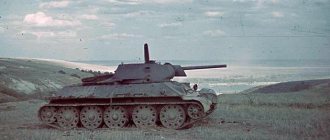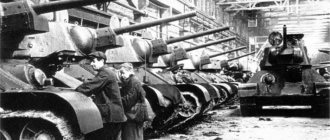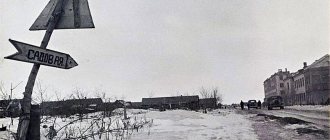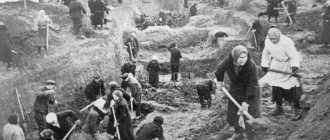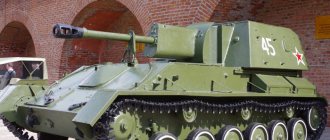In honor of this date, as well as the 85th anniversary of Uralvagonzavod and the 80th anniversary of the Ural Design Bureau of Transport Engineering (Uralvagonzavod Concern is part of the Rostec State Corporation), three tanks demonstrated to media representatives their high driving and combat qualities at the test site. As part of the press tour, T-34-85, T-90M Proryv and T-14 on the Armata platform took to the track. The tanks accelerated dynamically, drifted around the site, and drove through with flares in the colors of the Russian flag. The T-90M demonstrated firing from a cannon, and the T-14 easily climbed a hill about 6 meters high and an incline of 30 degrees.
These three tanks represent different eras and generations, reflect the evolution of design ideas and clearly demonstrate the main qualities inherent in UKBTM and UVZ vehicles. They have always been distinguished by reliability, simplicity of design, high maintainability and practically inexhaustible modernization potential. So, for example, its designer Alexander Morozov wrote about the T-34 tank:
“Unlike supporters of any abstruse solutions, we proceeded from the fact that the design should be simple, without anything superfluous, random or contrived. Making a complex machine, of course, is always easier than a simple one, which not every designer can handle... The structural simplicity of the T-34 tank made it possible, at the most difficult moment for the Motherland, not only to have tanks, but to have many, much more of them than the enemy had . It made it possible to quickly organize the production of combat vehicles at many factories in the country that had not previously produced such equipment, and by people who previously knew about tanks only by hearsay.”
© UVZ Press Service The structural simplicity of the T-34 tank made it possible to quickly organize the production of combat vehicles at many factories in the country.
By the end of May 1945, the Nizhny Tagil plant produced 25,914 "thirty-fours" - more than all German factories combined. And the production of armored vehicles at Uralvagonzavod started with the beginning of the Great Patriotic War.
Symbol of the Great Victory
On September 13, 1941, in connection with the approach of the front line to the Kharkov industrial region, the Council of People's Commissars of the USSR issued a decree on the evacuation of Kharkov plant No. 183 and the Mariupol metallurgical plant to the east. In December, on the basis of these enterprises, Uralvagonzavod named after. F.E. Dzerzhinsky, as well as a number of evacuated production facilities, the Ural Tank Plant No. 183 began its work, which became one of the largest defense complexes in the country. The plant team had to quickly establish mass production of T-34 medium tanks for the army at the existing production facilities.
More than three thousand pieces of equipment were brought and installed, about 70 thousand people (including families) were evacuated. In the shortest possible time, in just two months, the production capacity of the Tagil enterprise was completely repurposed for the production of tanks, and on December 18, 1941, the first T-34-76 tank was assembled from components that arrived from Kharkov.
Designers and technologists had to improve many components and parts, based on the capabilities of UTZ and taking into account the lack of qualified personnel. During the war period, the Ural Tank Plant successfully played the role of the main enterprise for the production of the Thirty-Four. The design bureau had to develop a number of components, parts and even mechanisms in several versions, taking into account the technical capabilities of a particular plant.
For example, by January 1942, changes were made to the drawings of 770 items of parts, and 1,265 items of parts were simply removed from the design. At the same time, despite the short time frame and the lack of experimental verification of the changed and new designs, no further errors were identified. At the same time, the production technology was simplified.
© UVZ Press Service
In January 1944, a modification of the T-34 with a more powerful 85-mm cannon, the T-34-85 tank, was put into service.
And to increase the production of tanks, the most advanced technologies for that time were introduced into production: casting turrets in raw molds made by machine molding, automatic welding of armored hulls, and others. For the first time in the world, flow-conveyor assembly of tanks was introduced. Since May 1942, a “thirty-four” rolled off the assembly line every 30 minutes. Every day the Ural Tank Plant sent a train of combat vehicles to the front. In general, the scale of use of production lines and various conveyors at the plant during wartime had no analogues in the world tank building - both in those years and today.
A huge amount of work has also been done to improve the combat characteristics of the T-34. In January 1944, a modification of the T-34 with a more powerful 85-mm cannon was put into service - the T-34-85 tank, which two months later began to roll off the UTZ assembly line. It was he who became the symbol of the Great Victory.
T-34 tanks are still in service in some countries! And the “thirty-four” that took part in the event rolled off the plant’s assembly line in 1945. Despite her venerable age, she still takes part in city Victory parades and historical reconstructions. At the training ground, the T-34-85, along with its younger brothers, demonstrated turns, sharp turns, and driving performance.
General's "Abrams"
Count Dmitry Milyutin predicted a great future for armored combat vehicles, and the last Russian field marshal turned out to be right: over time, tanks took a strong place in the armed forces of the world along with mobile artillery. One of the most recognizable tanks of our time is the sand-colored American M1 Abrams, named after World War II and Vietnam War general Creighton Abrams. Giant US armored combat vehicles weighing 63 tons and having an engine of 1.5 thousand horsepower have crushing power.
M1 Abrams
"Abrams" are quite maneuverable despite their weight and on the highway they reach speeds of more than 70 kilometers per hour, and the guns are loaded manually. The most significant disadvantage of the tank in battle was the design of an additional installation to power all systems in the event of failure of the main engine. Due to its location outside the Abrams turret, it was easy to set fire to the engine: burning fuel and oil could enter the engine, and the installation was later moved to the left fender. The Abrams, which has undergone many modernizations, has not only remained the main tank of the American ground forces since the eighties of the last century, but is also exported. These tanks were used during the war in the Persian Gulf, Iraq and Yemen, the power and weight of the Abrams may vary depending on the modifications, of which there are more than twenty-six, but they are all distinguished by advanced sighting systems and ammunition with enormous destructive power.
One of a kind
The epithets “first”, “unique”, “one of a kind” can be applied to each subsequent Uralvagonzavod tank. At the turn of the 1940s-1950s, the T-54 medium tank, armed with the most powerful 100 mm cannon for that time, was put on the production line. Numerous Soviet divisions equipped with T-54 tanks in the 1950s were a strategic factor compensating for our country’s temporary lag in nuclear weapons. For ten years, the absolute superiority of the 54s over their opponents—the tanks of NATO countries—prevented the Cold War from escalating into World War III.
Since 1958, Uralvagonzavod began serial production of the T-55, the world’s first tank equipped with an integrated anti-radiation protection system, allowing it to operate in areas contaminated after a nuclear strike. The highest reliability, simplicity and combat effectiveness of this vehicle made the T-55 tank the most popular tank in the world in 1960-1970.
© Alexander Kotelnikov
T-54 in the museum of armored vehicles of Uralvagonzavod.
And in the early 1960s, the T-62 tank was put into service. It was the first in the world to be equipped with a smoothbore gun with a high initial velocity of an armor-piercing sub-caliber projectile. Protection capable of withstanding the attack of such a BPS appeared on the main NATO tanks only at the turn of 1970-1980.
The most popular modern tank, the T-72, entered service in 1973, forms the basis of the ground forces of many countries around the world. The ideal combination of cost and efficiency, together with almost inexhaustible modernization reserves, made it a real “star” on the battlefield. Tagil specialists began improving the T-72 - then still a prototype "object 172M" - immediately after its birth in 1970.
New modifications were developed through careful selection of the most successful solutions, both constructive and technological. And their correctness was tested at the training ground, test marches and battles. For two decades, the army received serial tanks T-72A, T-72B and engineering vehicles created on their basis - the MTU-72 bridge laying vehicle and the BREM-1 armored repair and recovery vehicle.
Improvement of the “seventy-two” is ongoing to this day: today T-72B3M tanks are being supplied to the troops. The modernization affected almost all systems, as a result of which the maneuverability of the vehicles improved, their firepower and level of security increased.
© UVZ Press Service
Assembly shop of Uralvagonzavod.
And at the press tour, the connection between generations and the possibility of modernization was presented by the T-90M “Breakthrough” - the most modern in the “nineties” family. Its predecessor, the T-90, is another Uralvagonzavod tank, famous for its highest reliability. The export version of the “nineties” is the most commercially successful tank of the 21st century. And not without reason: it successfully overcame the most difficult tests in various climatic zones of three countries at once - Saudi Arabia, Malaysia and India.
Thus, during tests in the Indian Thar desert in the summer of 1999, three T-90S tanks showed such endurance that is unlikely to be demonstrated by any other vehicle in the world. In the desert, with daytime air temperatures of up to 53 degrees and night temperatures of about 30 degrees Celsius, with an almost complete absence of roads, each Tagil tank traveled more than two thousand kilometers. The Indian military highly appreciated the results of the tests, and a great achievement for Uralvagonzavod was the signing of a contract for the supply of a large batch of T-90S tanks to India.
This contract became a real salvation for Uralvagonzavod, since the crisis and collapse of the Soviet Union had an extremely difficult impact on the enterprise, as well as on many other large factories in the country. During the 1990s, there were years when the state did not order a single tank at all, and places on world markets still had to be won. In order to retain specialists, and, consequently, production potential, Uralvagonzavod had to make a lot of efforts in finding additional orders for armored vehicles. The plant was engaged in restoring old tanks and producing spare parts for them. The production of the main battle tank of the Russian Army T-90A and the sale of its export version of the T-90S tank abroad became the main achievement of Uralvagonzavod designers in the early 2000s.
© Alexander Kotelnikov
At the press tour, the connection between generations and the possibility of modernization was presented by the T-90M “Breakthrough” - the most modern in the “nineties” family.
According to the “efficiency-cost” criterion, the T-90S has no competitors today. But the designers wanted to reach the highest positions in the world rankings. To this end, in the 2000s, UKBTM and Uralvagonzavod carried out development work, which resulted in the appearance of first the T-90MS tank, and later the T-90M Proryv. The modernization of the “nineties” turned out to be so multi-level that the T-90M “Breakthrough” can rightfully be considered a new combat vehicle. The turret was completely replaced, the power and transmission units and chassis were modernized, and the level of armor resistance was increased.
— “Proryv” is a powerful and very comfortable car. The controls are easy. It's like a bicycle: once you learn it, you'll never forget it! T-90M - a tank for the modern army! - says Maxim Gorbunov, test controller of combat and special vehicles at Uralvagonzavod.
— According to the Indian military, the T-90 tank is the second deterrent weapon after the nuclear one. This is one example that tanks are really needed and will remain in demand for a long time. Today, Uralvagonzavod is fulfilling contracts for the supply of T-72B3M, T-90M tanks, and for the production of T-14. These are vehicles of different classes, with different combat capabilities, but they are all in demand by the Russian army, and we see that foreign customers are also choosing between these three tanks,” noted Ilya Makeev, deputy chief designer of UKBTM JSC.
© Alexander Kotelnikov
The future of world tank building is the T-14 on the Armata platform.
Porokhovshchikov's all-terrain vehicle
It is believed that the prototype of the first Russian super-heavy tank was invented by the son of the creator of the periodic table of elements, shipbuilding engineer Vasily Mendeleev. Mendeleev presented the drawings of his “Armored Car,” more like an armored carriage, to the War Ministry in 1916, when neither English nor French tanks existed. The project was not brought to life, unlike another tank prototype - a tracked all-terrain vehicle. The predecessor of the single-seat maneuverable wedge was designed by the pilot Alexander Porokhovshchikov, the grandfather of the famous actor: he presented the all-terrain vehicle to the public a year before Mendeleev, and his project was recognized as promising, but by 1916 the funding was curtailed.
Porokhovshchikov's all-terrain vehicle
The authorities again remembered the all-terrain vehicle a year later, when the British presented their tanks - in the Russian press they were called “tubs,” loosely translating the word tank. Porokhovshchikov did not stand aside: he improved his invention, and the All-Terrain Vehicle No. 2 model no longer had one, but four seats for the crew, multi-layer armor and a wheelhouse with three Maxim machine guns. However, this project was not put into mass production - the army technical commission considered it unpromising, and until the end of the revolution the country did not return to tank building. However, there is a car that looked much stranger than Porokhovshchikov’s all-terrain vehicle - this is an invention of German engineers in the 1930s, the Kugelpanzer two-wheeled round armored vehicle. The only surviving copy, which was captured by Soviet troops in Manchuria, is kept in the armored museum in Kubinka near Moscow. There is also the most massive tank in history, the German super-heavy “Maus” weighing more than 180 tons, also preserved in a single copy: only two, according to some sources, three such tanks were embodied in metal.




